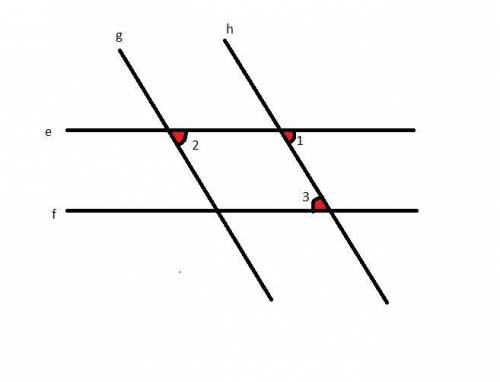
Mathematics, 22.04.2020 18:59 only1cache
Given: g ∥ h and ∠2 ≅ ∠3
Prove: e ∥ f
Horizontal and parallel lines e and f are intersected by diagonal and parallel lines g and h. At the intersection of lines g and e, the bottom right angle is angle 2. At the intersection of lines h and e, the bottom right angle is angle 1. At the intersection of lines f and h, the top left angle is angle 3.
Statements Reasons
1. g || h 1. given
2. ∠1 ≅ ∠2 2. corresponding angles theorm
3. ∠2 ≅ ∠3 3. given
4. ∠1 ≅ ∠3 4. transitive property
5. e || f 5. ?
What is the missing reason in the proof?
vertical angles theorem
alternate exterior angles theorem
converse corresponding angles theorem
converse alternate interior angles theorem

Answers: 2


Another question on Mathematics


Mathematics, 21.06.2019 18:00
Aman is 6 feet 3 inches tall. the top of his shadow touches a fire hydrant that is 13 feet 6 inches away. what is the angle of elevation from the base of the fire hydrant to the top of the man's head?
Answers: 1

Mathematics, 21.06.2019 18:00
Ammonia molecules have three hydrogen atoms and one nitrogen atom.how many of each atom arein five molecules of ammonia
Answers: 1

Mathematics, 21.06.2019 22:00
Which statements describe the solutions to the inequality x< -20 check all that apply. there are infinite solutions. each solution is negative. each solution is positive. the solutions are both positive and negative. the solutions contain only integer values. the solutions contain rational number values.
Answers: 1
You know the right answer?
Given: g ∥ h and ∠2 ≅ ∠3
Prove: e ∥ f
Horizontal and parallel lines e and f...
Prove: e ∥ f
Horizontal and parallel lines e and f...
Questions




Mathematics, 31.08.2019 07:10


History, 31.08.2019 07:10

Mathematics, 31.08.2019 07:10

Social Studies, 31.08.2019 07:10


English, 31.08.2019 07:10


Biology, 31.08.2019 07:10


Mathematics, 31.08.2019 07:10

Mathematics, 31.08.2019 07:10

Social Studies, 31.08.2019 07:10




History, 31.08.2019 07:10

 and
and  .
. , by corresponding angles (same side of the transversal, one interior, the other exterior to parallels).
, by corresponding angles (same side of the transversal, one interior, the other exterior to parallels). , we must demonstrate a congruence between angle 2 and an angle on the intersection between line g and line f.
, we must demonstrate a congruence between angle 2 and an angle on the intersection between line g and line f.
 is the angle at the intersection line g and line f.
is the angle at the intersection line g and line f.




